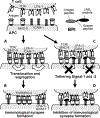Bioconjugate Strategies for the Induction of Antigen-Specific Tolerance in Autoimmune Diseases
- PMID: 29165988
- PMCID: PMC6886668
- DOI: 10.1021/acs.bioconjchem.7b00632
Bioconjugate Strategies for the Induction of Antigen-Specific Tolerance in Autoimmune Diseases
Abstract
Antigen-specific immunotherapy (ASI) holds great promise for the treatment of autoimmune diseases. In mice, administration of major histocompatibility complex (MHC) binding synthetic peptides which modulate T cell receptor (TCR) signaling under subimmunogenic conditions induces selective tolerance without suppressing the global immune responses. However, clinical translation has yielded limited success. It has become apparent that the TCR signaling pathway via synthetic peptide antigen alone is inadequate to induce an effective tolerogenic immunity in autoimmune diseases. Bioconjugate strategies combining additional immunomodulatory functions with TCR signaling can amplify the antigen-specific immune tolerance and possibly lead to the development of new treatments in autoimmune diseases. In this review, we provide a summary of recent advances in the development of bioconjugates to achieve antigen-specific immune tolerance in vivo, with the discussion focused on the underlying design principles and challenges that must be overcome to target these therapies to patients suffering from autoimmune diseases.
Figures






Similar articles
-
Antigen-specific tolerance strategies for the prevention and treatment of autoimmune disease.Nat Rev Immunol. 2007 Sep;7(9):665-77. doi: 10.1038/nri2153. Epub 2007 Aug 10. Nat Rev Immunol. 2007. PMID: 17690713 Review.
-
Heat shock protein bystander antigens for peptide immunotherapy in autoimmune disease.Clin Exp Immunol. 2013 Jan;171(1):20-9. doi: 10.1111/j.1365-2249.2012.04627.x. Clin Exp Immunol. 2013. PMID: 23199319 Free PMC article. Review.
-
Polymeric synthetic nanoparticles for the induction of antigen-specific immunological tolerance.Proc Natl Acad Sci U S A. 2015 Jan 13;112(2):E156-65. doi: 10.1073/pnas.1408686111. Epub 2014 Dec 29. Proc Natl Acad Sci U S A. 2015. PMID: 25548186 Free PMC article.
-
Ternary complex therapy for autoimmune disease.Hosp Pract (1995). 1995 Aug 15;30(8):57-8, 60-2, 64-5. doi: 10.1080/21548331.1995.11443243. Hosp Pract (1995). 1995. PMID: 7635912
-
Immunological mechanisms involved in experimental peptide immunotherapy of T-cell-mediated diseases.Crit Rev Immunol. 2000;20(6):451-69. Crit Rev Immunol. 2000. PMID: 11396681 Review.
Cited by
-
Recent Advances in Antigen-Specific Immunotherapies for the Treatment of Multiple Sclerosis.Brain Sci. 2020 May 29;10(6):333. doi: 10.3390/brainsci10060333. Brain Sci. 2020. PMID: 32486045 Free PMC article. Review.
-
Glycosylation-modified antigens as a tolerance-inducing vaccine platform prevent anaphylaxis in a pre-clinical model of food allergy.Cell Rep Med. 2024 Jan 16;5(1):101346. doi: 10.1016/j.xcrm.2023.101346. Epub 2023 Dec 20. Cell Rep Med. 2024. PMID: 38128531 Free PMC article.
-
Vaccination by Two DerG LEAPS Conjugates Incorporating Distinct Proteoglycan (PG, Aggrecan) Epitopes Provides Therapy by Different Immune Mechanisms in a Mouse Model of Rheumatoid Arthritis.Vaccines (Basel). 2021 May 2;9(5):448. doi: 10.3390/vaccines9050448. Vaccines (Basel). 2021. PMID: 34063326 Free PMC article.
-
In Vivo Expansion of Antigen-Specific Regulatory T Cells through Staggered Fc.IL-2 Mutein Dosing and Antigen-Specific Immunotherapy.Immunohorizons. 2021 Sep 28;5(9):782-791. doi: 10.4049/immunohorizons.2100051. Immunohorizons. 2021. PMID: 34583939 Free PMC article.
-
Tailored therapeutics based on 1,2,3-1H-triazoles: a mini review.Medchemcomm. 2019 May 14;10(8):1302-1328. doi: 10.1039/c9md00218a. eCollection 2019 Aug 1. Medchemcomm. 2019. PMID: 31534652 Free PMC article. Review.
References
-
- Wang L, Wang FS, and Gershwin ME (2015) Human autoimmune diseases: a comprehensive update. J. Intern. Med 278, 369–395. - PubMed
-
- https://www.niaid.nih.gov/diseases-conditions/autoimmune-diseases. Retrieved Nov. 18, 2017.
Publication types
MeSH terms
Substances
Grants and funding
LinkOut - more resources
Full Text Sources
Other Literature Sources
Medical
Research Materials

